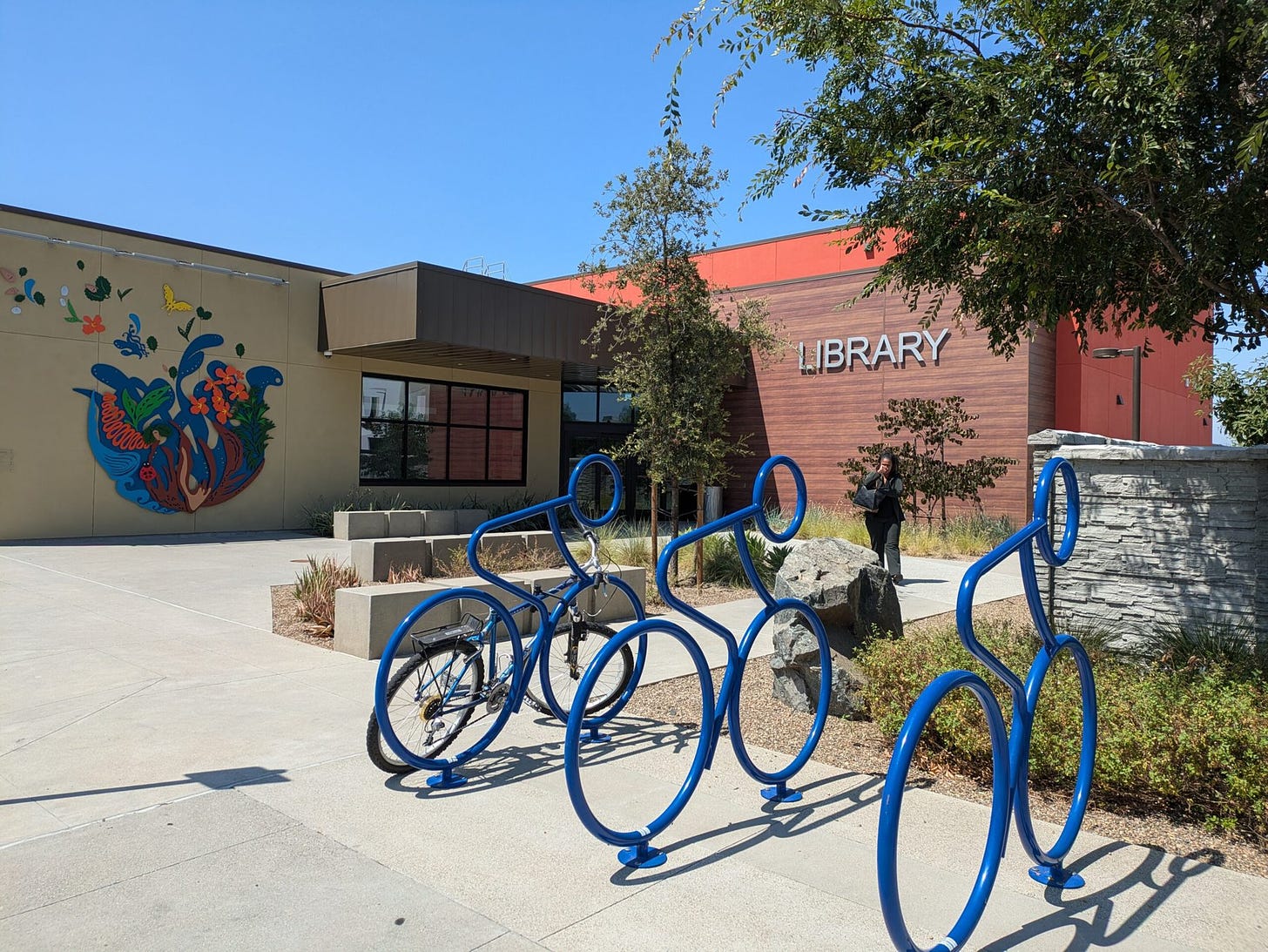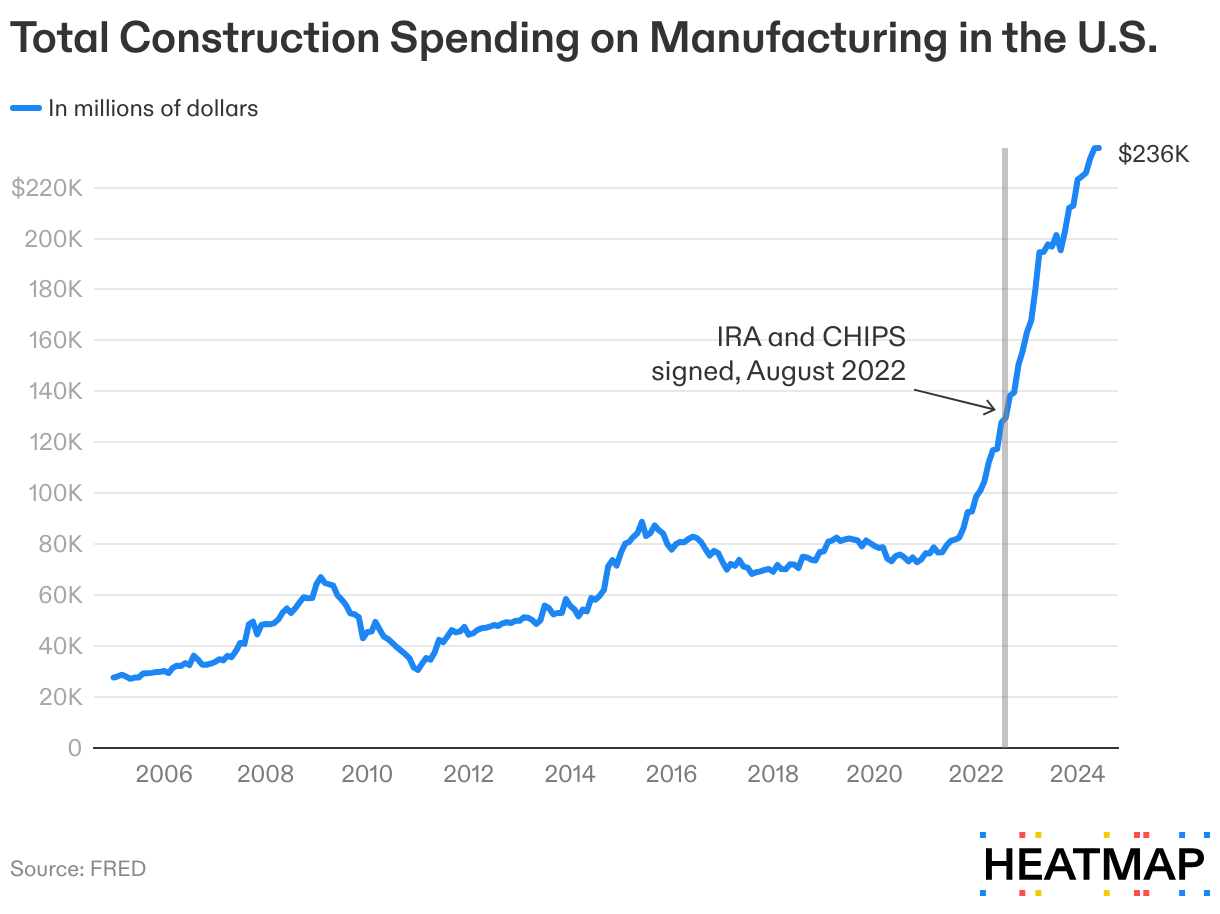Now for Something Different: Promising Developments from Across the Country.
From libraries to factories to college rankings, some things are moving in the right direction. Let's pause to notice a few of them.
The Lakeside branch of the San Diego County Library system, which is part of a nationwide trend of libraries embracing ‘sustainability’ in all forms. The steady evolution of libraries is one of many promising developments that easily get lost in the chaos of political and culture-war news. (Photo by Deborah Fallows, as is one of the stories mentioned below.)
This post presents a number of updates, links, citations, and reminders about things going on outside the blinding lights of campaign reporting. Most of them are positive. These stories are about people, organizations, and communities making things better rather than worse. In all of them I’m giving the main point rather than telling the full story. My hope is that you’ll check out more from the links.
Here is the list:
1. ‘Manufacturing is Back, Baby.’
From Jesse Jenkins, of Princeton, a detailed look at recent US industrial policy that has worked. Jenkins’s post is on the excellent new climate-related site called Heatmap. The piece is about the the Biden-era “industrial policy” that has emerged from major legislation—the CHIPS act to advance US semiconductor production, the climate policies grouped as the Inflation Reduction Act, and the many projects launched under the major infrastructure bill—plus other executive measures.
As Jenkins sums it up:
Those new laws (and other Biden-Harris Administration actions on trade and tariffs1) have directed and amplified a megatrend in “reshoring” and driven a huge surge in private sector investments in U.S. manufacturing, creating tens of thousands of good jobs in communities across America. Investment in manufacturing construction has more than doubled since passage of the IRA and CHIPS, and the U.S. has seen nearly 127,000 new jobs created, according to Energy Innovation policy analyst Jack Conness.
He adds this chart.
There is much more in the article, which I recommend. It is also worth reading the detailed analysis by Jack Conness that Jenkins mentions in his post.
Apart from the overall impact of these measures, Jenkins stresses how strongly the benefits have been concentrated in “left-behind” parts of the country: smaller towns, rural areas, former industrial centers, and so on. As it works out, most of the investments have gone to states, communities, and probably individual people who voted for Donald Trump. In the footnotes below2 I include a fascinating note from someone in the energy business, about why the spending has followed this pattern. The note also reflects on why our politics-obsessed media have paid so little attention to this manufacturing, climate-related, and jobs-creating boom.
2. Dayton launches ‘onMain.’
In a similar vein, I’m delighted to learn that a major new project led by the University of Dayton and a broad coalition in Dayton, Ohio has received significant new funding. You can read the official announcement here and see mockups of the prospective “onMain” development here.
I’ve visited this site and talked with its visionaries several times over the past five-plus years. It’s gratifying to see them take this step, which will help revive a large part of downtown. It aims to convert a very large, centrally placed, now run-down part of town into a new center of business and cultural activity—the kind of change DC-ites have seen with the Wharf area over the past decade, and that many other cities have undergone.
I’ve written in dispatches from Muncie, Erie, Waterville ME, and elsewhere, about colleges and universities that see their own future as being tied to the well-being of their home community. That’s been the secret to transformations of many “left-behind” locations that happen to have a college or university near by. Congratulations to those working so hard to bring these improvements to Dayton.
3. The right kind of college rankings.
Speaking of colleges—and speaking of the magazine in which I published those Muncie and Erie stories—The Washington Monthly is out with the latest installment of its pioneering approach to college rankings. You can see the list and all the accompanying articles here.
I’ve written endless articles about the damage done by the wrong kind of college rankings (I speak as a onetime editor of US News) and about the benefits of the sane, practical-minded, anti-snobbish approach spearheaded by The Washington Monthly. Here is a sample from three years ago, with links to other pieces.
An adage of government, business, and life in general is that when you measure something, you get more of it. Congratulations to my friends at the Monthly for re-casting the way we measure, think about, and value higher education.
4. Libraries go ‘sustainable.’
For nearly a decade, Deb Fallows has been chronicling the way public libraries have transformed themselves from seeming like “yesterday’s” institutions, to tomorrow’s and today’s. You can see many of her past articles here. One of the themes she has helped popularize is the way libraries have positioned themselves as society’s “second responders”—stepping up to do what a community needs, after the emergency first-responders are finished.
This month Deb wrote about the latest pioneering movement in libraries, that of embracing ‘sustainability’ in all its dimensions. Her reporting involves libraries across the country but is centered in San Diego. I think you’ll enjoy the original thinking and data in her article.
Also on the local-institutional front: From our friends in the GIS world, which is where Deb and I first met Tim Walz, we learned about a blog called The Ernest Blair Experiment, from a geographer who is based in Nova Scotia. It chronicles small-town and rural revival and innovation and is worth exploring. Also, check out this Baltimore Banner piece by Brenna Smith on how the era of remote work has revived the small, far-western-Maryland town of Cumberland.
In a similar vein: It’s worth reading this new essay by Rachel Cohen, in Vox, about her slow, hard-earned appreciation of how much it matters to be involved in unglamorous, person-by-person service and volunteer work in her community. This is (yet another) under-appreciated part of America’s current social fabric. Stay tuned for more on this theme.
5. Re-inventing, or at least re-capitalizing, journalism, from Minnesota to California.
This month our friend Steve Grove—who was Minnesota’s commissioner of employment and economic development during Tim Walz’s first term, and is now publisher and chief executive of the well-known Star Tribune in Minneapolis—introduced a new look, ambition, and business model for the paper. The NYT covered its plans here. The paper is officially changing its name to the Minnesota Star Tribune, reflecting its state-wide coverage plans, and has embraced the view that news organizations cannot solve their problems through endless cutbacks.
The Times report said that, amid newspaper crises,
The Star Tribune has remained a bright spot: It hasn’t made major layoffs in recent years, and its newsroom has remained around 225 people for years.
The Star Tribune is owned by Glen Taylor, a billionaire who also owns the Minnesota Timberwolves and the Minnesota Lynx. He bought the paper for about $100 million in 2014, several years after it filed for bankruptcy.
The paper has been profitable every year since, but until now, Mr. Taylor had not invested more into the publication, Mr. Grove said.
Now he is investing. Godspeed to them all.
And in California, Assemblywoman Buffy Wicks has led efforts toward a deal that will transfer some $175 million from tech companies that have been using news generated by local papers (think: Google) into endowments to support those news organizations. You can read about it at Cal-Matters and at the Rebuild Local News site. As Steve Waldman, the innovator (and longtime friend) who leads RLN, put it:
Although there is much left to do [this] is a step forward and a down-payment on a strategy to revive local news in California. Along with similar steps taken recently in New York and Illinois, there is now a real movement underway to help save local news through public policy….3
As the saying goes: Maybe nothing can save local journalism. But maybe everything can.4
6. ‘Which Side Are You On?’
Now, back to the reality of 69 days until the election.





